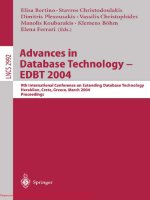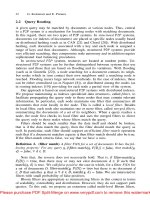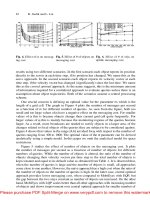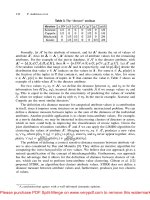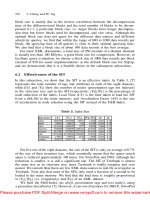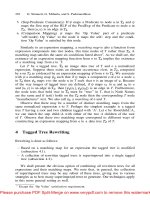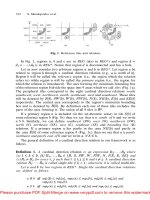advances in elliptic curve cryptography
Bạn đang xem bản rút gọn của tài liệu. Xem và tải ngay bản đầy đủ của tài liệu tại đây (4.66 MB, 299 trang )
P1: GCV
CY546/Blake-FM 0 521 60415 X October 19, 2004 14:14
viii
This page intentionally left blank
P1: GCV
CY546/Blake-FM 0 521 60415 X October 19, 2004 14:14
LONDON MATHEMATICAL SOCIETY LECTURE NOTE SERIES
Managing Editor: Professor N.J. Hitchin, Mathematical Institute,
University of Oxford, 24–29 St Giles, Oxford OX1 3LB, United Kingdom
The titles below are available from booksellers, or from Cambridge University Press at www.cambridge.org
152 Oligomorphic permutation groups, P. CAMERON
153 L-functions and arithmetic, J. COATES & M.J. TAYLOR (eds)
155 Classification theories of polarized varieties, TAKAO FUJITA
158 Geometry of Banach spaces, P.F.X. M
¨
ULLER & W. SCHACHERMAYER (eds)
159 Groups St Andrews 1989 volume 1, C.M. CAMPBELL & E.F. ROBERTSON (eds)
160 Groups St Andrews 1989 volume 2, C.M. CAMPBELL & E.F. ROBERTSON (eds)
161 Lectures on block theory, BURKHARD K
¨
ULSHAMMER
163 Topics in varieties of group representations, S.M. VOVSI
164 Quasi-symmetric designs, M.S. SHRIKANDE & S.S. SANE
166 Surveys in combinatorics, 1991, A.D. KEEDWELL (ed)
168 Representations of algebras, H. TACHIKAWA & S. BRENNER (eds)
169 Boolean function complexity, M.S. PATERSON (ed)
170 Manifolds with singularities and the Adams-Novikov spectral sequence, B. BOTVINNIK
171 Squares, A.R. RAJWADE
172 Algebraic varieties, GEORGE R. KEMPF
173 Discrete groups and geometry, W.J. HARVEY & C. MACLACHLAN (eds)
174 Lectures on mechanics, J.E. MARSDEN
175 Adams memorial symposium on algebraic topology 1, N. RAY & G. WALKER (eds)
176 Adams memorial symposium on algebraic topology 2, N. RAY & G. WALKER (eds)
177 Applications of categories in computer science, M. FOURMAN, P. JOHNSTONE & A. PITTS (eds)
178 Lower K- and L-theory, A. RANICKI
179 Complex projective geometry, G. ELLINGSRUD et al
180 Lectures on ergodic theory and Pesin theory on compact manifolds, M. POLLICOTT
181 Geometric group theory I, G.A. NIBLO & M.A. ROLLER (eds)
182 Geometric group theory II, G.A. NIBLO & M.A. ROLLER (eds)
183 Shintani zeta functions, A. YUKIE
184 Arithmetical functions, W. SCHWARZ & J. SPILKER
185 Representations of solvable groups, O. MANZ & T.R. WOLF
186 Complexity: knots, colourings and counting, D.J.A. WELSH
187 Surveys in combinatorics, 1993, K. WALKER (ed)
188 Local analysis for the odd order theorem, H. BENDER & G. GLAUBERMAN
189 Locally presentable and accessible categories, J. ADAMEK & J. ROSICKY
190 Polynomial invariants of finite groups, D.J. BENSON
191 Finite geometry and combinatorics, F. DE CLERCK et al
192 Symplectic geometry, D. SALAMON (ed)
194 Independent random variables and rearrangement invariant spaces, M. BRAVERMAN
195 Arithmetic of blowup algebras, WOLMER VASCONCELOS
196 Microlocal analysis for differential operators, A. GRIGIS & J. SJ
¨
OSTRAND
197 Two-dimensional homotopy and combinatorial group theory, C. HOG-ANGELONI et al
198 The algebraic characterization of geometric 4-manifolds, J.A. HILLMAN
199 Invariant potential theory in the unit ball of C
n
, MANFRED STOLL
200 The Grothendieck theory of dessins d’enfant, L. SCHNEPS (ed)
201 Singularities, JEAN-PAUL BRASSELET (ed)
202 The technique of pseudodifferential operators, H.O. CORDES
203 Hochschild cohomology of von Neumann algebras, A. SINCLAIR & R. SMITH
204 Combinatorial and geometric group theory, A.J. DUNCAN, N.D. GILBERT & J. HOWIE (eds)
205 Ergodic theory and its connections with harmonic analysis, K. PETERSEN & I. SALAMA (eds)
207 Groups of Lie type and their geometries, W.M. KANTOR & L. DI MARTINO (eds)
208 Vector bundles in algebraic geometry, N.J. HITCHIN, P. NEWSTEAD & W.M. OXBURY (eds)
209 Arithmetic of diagonal hypersurfaces over finite fields, F.Q. GOUV
´
EA&N.YUI
210 Hilbert C*-modules, E.C. LANCE
211 Groups 93 Galway / St Andrews I, C.M. CAMPBELL et al (eds)
212 Groups 93 Galway / St Andrews II, C.M. CAMPBELL et al (eds)
214 Generalised Euler-Jacobi inversion formula and asymptotics beyond all orders, V. KOWALENKO et al
215 Number theory 1992–93, S. DAVID (ed)
216 Stochastic partial differential equations, A. ETHERIDGE (ed)
217 Quadratic forms with applications to algebraic geometry and topology, A. PFISTER
218 Surveys in combinatorics, 1995, PETER ROWLINSON (ed)
220 Algebraic set theory, A. JOYAL & I. MOERDIJK
221 Harmonic approximation, S.J. GARDINER
222 Advances in linear logic, J Y. GIRARD, Y. LAFONT & L. REGNIER (eds)
223 Analytic semigroups and semilinear initial boundary value problems, KAZUAKI TAIRA
224 Computability, enumerability, unsolvability, S.B. COOPER, T.A. SLAMAN & S.S. WAINER (eds)
225 A mathematical introduction to string theory, S. ALBEVERIO et al
226 Novikov conjectures, index theorems and rigidity I, S. FERRY, A. RANICKI & J. ROSENBERG (eds)
227 Novikov conjectures, index theorems and rigidity II, S. FERRY, A. RANICKI & J. ROSENBERG (eds)
228 Ergodic theory of Z
d
actions, M. POLLICOTT & K. SCHMIDT (eds)
229 Ergodicity for infinite dimensional systems, G. DA PRATO & J. ZABCZYK
230 Prolegomena to a middlebrow arithmetic of curves of genus 2, J.W.S. CASSELS & E.V. FLYNN
i
P1: GCV
CY546/Blake-FM 0 521 60415 X October 19, 2004 14:14
231 Semigroup theory and its applications, K.H. HOFMANN & M.W. MISLOVE (eds)
232 The descriptive set theory of Polish group actions, H. BECKER & A.S. KECHRIS
233 Finite fields and applications, S. COHEN & H. NIEDERREITER (eds)
234 Introduction to subfactors, V. JONES & V.S. SUNDER
235 Number theory 1993–94, S. DAVID (ed)
236 The James forest, H. FETTER & B. GAMBOA DE BUEN
237 Sieve methods, exponential sums, and their applications in number theory, G.R.H. GREAVES et al
238 Representation theory and algebraic geometry, A. MARTSINKOVSKY & G. TODOROV (eds)
240 Stable groups, FRANK O. WAGNER
241 Surveys in combinatorics, 1997, R.A. BAILEY (ed)
242 Geometric Galois actions I, L. SCHNEPS & P. LOCHAK (eds)
243 Geometric Galois actions II, L. SCHNEPS & P. LOCHAK (eds)
244 Model theory of groups and automorphism groups, D. EVANS (ed)
245 Geometry, combinatorial designs and related structures, J.W.P. HIRSCHFELD et al
246 p-Automorphisms of finite p-groups, E.I. KHUKHRO
247 Analytic number theory, Y. MOTOHASHI (ed)
248 Tame topology and o-minimal structures, LOU VAN DEN DRIES
249 The atlas of finite groups: ten years on, ROBERT CURTIS & ROBERT WILSON (eds)
250 Characters and blocks of finite groups, G. NAVARRO
251 Gr¨obner bases and applications, B. BUCHBERGER & F. WINKLER (eds)
252 Geometry and cohomology in group theory, P. KROPHOLLER, G. NIBLO, R. ST
¨
OHR (eds)
253 The q-Schur algebra, S. DONKIN
254 Galois representations in arithmetic algebraic geometry, A.J. SCHOLL & R.L. TAYLOR (eds)
255 Symmetries and integrability of difference equations, P.A. CLARKSON & F.W. NIJHOFF (eds)
256 Aspects of Galois theory, HELMUT V
¨
OLKLEIN et al
257 An introduction to noncommutative differential geometry and its physical applications 2ed, J. MADORE
258 Sets and proofs, S.B. COOPER & J. TRUSS (eds)
259 Models and computability, S.B. COOPER & J. TRUSS (eds)
260 Groups St Andrews 1997 in Bath, I, C.M. CAMPBELL et al
261 Groups St Andrews 1997 in Bath, II, C.M. CAMPBELL et al
262 Analysis and logic, C.W. HENSON, J. IOVINO, A.S. KECHRIS & E. ODELL
263 Singularity theory, BILL BRUCE & DAVID MOND (eds)
264 New trends in algebraic geometry, K. HULEK, F. CATANESE, C. PETERS & M. REID (eds)
265 Elliptic curves in cryptography, I. BLAKE, G. SEROUSSI & N. SMART
267 Surveys in combinatorics, 1999, J.D. LAMB & D.A. PREECE (eds)
268 Spectral asymptotics in the semi-classical limit, M. DIMASSI & J. SJ
¨
OSTRAND
269 Ergodic theory and topological dynamics, M.B. BEKKA & M. MAYER
270 Analysis on Lie groups, N.T. VAROPOULOS & S. MUSTAPHA
271 Singular perturbations of differential operators, S. ALBEVERIO & P. KURASOV
272 Character theory for the odd order theorem, T. PETERFALVI
273 Spectral theory and geometry, E.B. DAVIES & Y. SAFAROV (eds)
274 The Mandlebrot set, theme and variations, TAN LEI (ed)
275 Descriptive set theory and dynamical systems, M. FOREMAN et al
276 Singularities of plane curves, E. CASAS-ALVERO
277 Computational and geometric aspects of modern algebra, M.D. ATKINSON et al
278 Global attractors in abstract parabolic problems, J.W. CHOLEWA & T. DLOTKO
279 Topics in symbolic dynamics and applications, F. BLANCHARD, A. MAASS & A. NOGUEIRA (eds)
280 Characters and automorphism groups of compact Riemann surfaces, THOMAS BREUER
281 Explicit birational geometry of 3-folds, ALESSIO CORTI & MILES REID (eds)
282 Auslander-Buchweitz approximations of equivariant modules, M. HASHIMOTO
283 Nonlinear elasticity, Y. FU & R.W. OGDEN (eds)
284 Foundations of computational mathematics, R. DEVORE, A. ISERLES & E. S
¨
ULI (eds)
285 Rational points on curves over finite fields, H. NIEDERREITER & C. XING
286 Clifford algebras and spinors 2ed, P. LOUNESTO
287 Topics on Riemann surfaces and Fuchsian groups, E. BUJALANCE, A.F. COSTA & E. MART
`
INEZ (eds)
288 Surveys in combinatorics, 2001, J. HIRSCHFELD (ed)
289 Aspects of Sobolev-type inequalities, L. SALOFF-COSTE
290 Quantum groups and Lie theory, A. PRESSLEY (ed)
291 Tits buildings and the model theory of groups, K. TENT (ed)
292 A quantum groups primer, S. MAJID
293 Second order partial differential equations in Hilbert spaces, G. DA PRATO & J. ZABCZYK
294 Introduction to the theory of operator spaces, G. PISIER
295 Geometry and integrability, LIONEL MASON & YAVUZ NUTKU (eds)
296 Lectures on invariant theory, IGOR DOLGACHEV
297 The homotopy category of simply connected 4-manifolds, H J. BAUES
299 Kleinian groups and hyperbolic 3-manifolds, Y. KOMORI, V. MARKOVIC, & C. SERIES (eds)
300 Introduction to M¨obius differential geometry, UDO HERTRICH-JEROMIN
301 Stable modules and the D(2)-problem, F.E.A. JOHNSON
302 Discrete and continuous nonlinear Schr¨odinger systems, M.J. ABLOWITZ, B. PRINARI, & A.D. TRUBATCH
303 Number theory and algebraic geometry, MILES REID & ALEXEI SKOROBOGATOV (eds)
304 Groups St Andrews 2001 in Oxford Vol. 1, COLIN CAMPBELL, EDMUND ROBERTSON & GEOFF SMITH (eds)
305 Groups St Andrews 2001 in Oxford Vol. 2, C.M. CAMPBELL, E.F. ROBERTSON & G.C. SMITH (eds)
307 Surveys in combinatorics 2003, C.D. WENSLEY (ed)
309 Corings and comodules, TOMASZ BRZEZINSKI & ROBERT WISBAUER
310 Topics in dynamics and ergodic theory, SERGEY BEZUGLYI & SERGIY KOLYADA (eds)
312 Foundations of computational mathematics, Minneapolis 2002, FELIPE CUCKER et al (eds)
ii
P1: GCV
CY546/Blake-FM 0 521 60415 X October 19, 2004 14:14
London Mathematical Society Lecture Note Series. 317
Advances in Elliptic Curve
Cryptography
Edited by
Ian F. Blake
University of Toronto
Gadiel Seroussi
Hewlett-Packard Laboratories
Nigel P. Smart
University of Bristol
iii
cambridge university press
Cambridge, New York, Melbourne, Madrid, Cape Town, Singapore, São Paulo
Cambridge University Press
The Edinburgh Building, Cambridge cb2 2ru, UK
First published in print format
isbn-13 978-0-521-60415-4
isbn-13 978-0-511-11161-7
© Cambridge University Press 2005
2005
Information on this title: www.cambrid
g
e.or
g
/9780521604154
This book is in copyright. Subject to statutory exception and to the provision of
relevant collective licensing agreements, no reproduction of any part may take place
without the written permission of Cambridge University Press.
isbn-10 0-511-11161-4
isbn-10 0-521-60415-x
Cambridge University Press has no responsibility for the persistence or accuracy of
urls for external or third-party internet websites referred to in this book, and does not
guarantee that any content on such websites is, or will remain, accurate or appropriate.
Published in the United States of America by Cambridge University Press, New York
www.cambridge.org
p
a
p
erback
eBook (MyiLibrary)
eBook (MyiLibrary)
p
a
p
erback
P1: GCV
CY546/Blake-FM 0 521 60415 X October 19, 2004 14:14
Contents
Preface page ix
Abbreviations and Standard Notation xi
Authors xv
Part 1. Protocols
Chapter I. Elliptic Curve Based Protocols
N.P. Smart 3
I.1. Introduction 3
I.2. ECDSA 4
I.3. ECDH/ECMQV 8
I.4. ECIES 12
I.5. Other Considerations 18
Chapter II. On the Provable Security of ECDSA
D. Brown 21
II.1. Introduction 21
II.2. Definitions and Conditions 23
II.3. Provable Security Results 32
II.4. Proof Sketches 33
II.5. Further Discussion 36
Chapter III. Proofs of Security for ECIES
A.W. Dent 41
III.1. Definitions and Preliminaries 42
III.2. Security Proofs for ECIES 50
III.3. Other Attacks Against ECIES 58
III.4. ECIES-KEM 61
v
P1: GCV
CY546/Blake-FM 0 521 60415 X October 19, 2004 14:14
vi Contents
Part 2. Implementation Techniques
Chapter IV. Side-Channel Analysis
E. Oswald 69
IV.1. Cryptographic Hardware 70
IV.2. Active Attacks 71
IV.3. Passive Attacks 72
IV.4. Simple SCA Attacks on Point Multiplications 77
IV.5. Differential SCA Attacks on Point Multiplications 84
Chapter V. Defences Against Side-Channel Analysis
M. Joye 87
V.1. Introduction 87
V.2. Indistinguishable Point Addition Formulæ 88
V.3. Regular Point Multiplication Algorithms 93
V.4. Base-Point Randomization Techniques 97
V.5. Multiplier Randomization Techniques 98
V.6. Preventing Side-Channel Analysis 100
Part 3. Mathematical Foundations
Chapter VI. Advances in Point Counting
F. Vercauteren 103
VI.1. p-adic Fields and Extensions 104
VI.2. Satoh’s Algorithm 105
VI.3. Arithmetic Geometric Mean 115
VI.4. Generalized Newton Iteration 121
VI.5. Norm Computation 128
VI.6. Concluding Remarks 132
Chapter VII. Hyperelliptic Curves and the HCDLP
P. Gaudry 133
VII.1. Generalities on Hyperelliptic Curves 133
VII.2. Algorithms for Computing the Group Law 136
VII.3. Classical Algorithms for HCDLP 140
VII.4. Smooth Divisors 142
VII.5. Index-Calculus Algorithm for Hyperelliptic Curves 144
VII.6. Complexity Analysis 146
VII.7. Practical Considerations 149
Chapter VIII. Weil Descent Attacks
F. Hess 151
VIII.1. Introduction – the Weil Descent Methodology 151
VIII.2. The GHS Attack 153
VIII.3. Extending the GHS Attack Using Isogenies 166
P1: GCV
CY546/Blake-FM 0 521 60415 X October 19, 2004 14:14
Contents vii
VIII.4. Summary of Practical Implications 173
VIII.5. Further Topics 175
Part 4. Pairing Based Techniques
Chapter IX. Pairings
S. Galbraith 183
IX.1. Bilinear Pairings 183
IX.2. Divisors and Weil Reciprocity 184
IX.3. Definition of the Tate Pairing 185
IX.4. Properties of the Tate Pairing 187
IX.5. The Tate Pairing over Finite Fields 189
IX.6. The Weil Pairing 191
IX.7. Non-degeneracy, Self-pairings and Distortion Maps 192
IX.8. Computing the Tate Pairing Using Miller’s Algorithm 196
IX.9. The MOV/Frey–R¨uck Attack on the ECDLP 197
IX.10. Supersingular Elliptic Curves 198
IX.11. Applications and Computational Problems from Pairings 201
IX.12. Parameter Sizes and Implementation Considerations 203
IX.13. Suitable Supersingular Elliptic Curves 204
IX.14. Efficient Computation of the Tate Pairing 205
IX.15. Using Ordinary Curves 208
Appendix: Proof of Weil Reciprocity 212
Chapter X. Cryptography from Pairings
K.G. Paterson 215
X.1. Introduction 215
X.2. Key Distribution Schemes 218
X.3. Identity-Based Encryption 221
X.4. Signature Schemes 228
X.5. Hierarchical Identity-Based Cryptography and Related Topics 235
X.6. More Key Agreement Protocols 240
X.7. Applications and Infrastructures 242
X.8. Concluding Remarks 250
Bibliography 253
Summary of Major LNCS Proceedings 271
Author Index 273
Subject Index 277
P1: GCV
CY546/Blake-FM 0 521 60415 X October 19, 2004 14:14
viii
Preface
It is now more than five years since we started working on the book Elliptic
Curves in Cryptography and more than four years since it was published. We
therefore thought it was time to update the book since a lot has happened
in the intervening years. However, it soon became apparent that a simple
update would not be sufficient since so much has been developed in this area.
We therefore decided to develop a second volume by inviting leading experts
to discuss issues which have arisen.
Highlights in the intervening years which we cover in this volume include:
Provable Security. There has been considerable work in the last few years
on proving various practical encryption and signature schemes secure. In this
new volume we will examine the proofs for the ECDSA signature scheme and
the ECIES encryption scheme.
Side-Channel Analysis. The use of power and timing analysis against
cryptographic tokens, such as smart cards, is particularly relevant to elliptic
curves since elliptic curves are meant to be particularly suited to the con-
strained environment of smart cards. We shall describe what side-channel
analysis is and how one can use properties of elliptic curves to defend against
it.
Point Counting. In 1999 the only method for computing the group order of
an elliptic curve was the Schoof-Elkies-Atkin algorithm. However, for curves
over fields of small characteristic we now have the far more efficient Satoh
method, which in characteristic two can be further simplified into the AGM-
based method of Mestre. We shall describe these improvements in this book.
Weil Descent. Following a talk by Frey in 1999, there has been considerable
work on showing how Weil descent can be used to break certain elliptic curve
systems defined over “composite fields” of characteristic two.
Pairing-Based Cryptography. The use of the Weil and Tate pairings was
until recently confined to breaking elliptic curve protocols. But since the
advent of Joux’s tripartite Diffie–Hellman protocol there has been an interest
in using pairings on elliptic curves to construct protocols which cannot be
implemented in another way. The most spectacular example of this is the
ix
xPREFACE
identity-based encryption algorithm of Boneh and Franklin. We describe not
only these protocols but how these pairings can be efficiently implemented.
As one can see once again, the breadth of subjects we cover will be of
interest to a wide audience, including mathematicians, computer scientists
and engineers. Once again we also do not try to make the entire book relevant
to all audiences at once but trust that, whatever your interests, you can find
something of relevance within these pages.
The overall style and notation of the first book is retained, and we have
tried to ensure that our experts have coordinated what they write to ensure
acoherent account across chapters.
Ian Blake
Gadiel Seroussi
Nigel Smart
Abbreviations and Standard Notation
Abbreviations
The following abbreviations of standard phrases are used throughout the
book:
AES Advanced Encryption Standard
AGM Arithmetic Geometric Mean
BDH Bilinear Diffie–Hellman problem
BSGS Baby Step/Giant Step method
CA Certification Authority
CCA Chosen Ciphertext Attack
CDH Computational Diffie–Hellman problem
CM Complex Multiplication
CPA Chosen Plaintext Attack
DBDH Decision Bilinear Diffie–Hellman problem
DDH Decision Diffie–Hellman problem
DEM Data Encapsulation Mechanism
DHAES Diffie–Hellman Augmented Encryption Scheme
DHIES Diffie–Hellman Integrated Encryption Scheme
DHP Diffie–Hellman Problem
DLP Discrete Logarithm Problem
DPA Differential Power Analysis
DSA Digital Signature Algorithm
DSS Digital Signature Standard
ECDDH Elliptic Curve Decision Diffie–Hellman problem
ECDH Elliptic Curve Diffie–Hellman protocol
ECDHP Elliptic Curve Diffie–Hellman Problem
ECDLP Elliptic Curve Discrete Logarithm Problem
ECDSA Elliptic Curve Digital Signature Algorithm
ECIES Elliptic Curve Integrated Encryption Scheme
ECMQV Elliptic Curve Menezes–Qu–Vanstone protocol
GHS Gaudry–Hess–Smart attack
GRH Generalized Riemann Hypothesis
HCDLP Hyperelliptic Curve Discrete Logarithm Problem
HIBE Hierarchical Identity-Based Encryption
xi
xii ABBREVIATIONS AND STANDARD NOTATION
IBE Identity-Based Encryption
IBSE Identity-Based Sign and Encryption
ILA Information Leakage Analysis
KDF Key Derivation Function
KDS Key Distribution System
KEM Key Encapsulation Mechanism
MAC Message Authentication Code
MOV Menezes–Okamoto–Vanstone attack
NIKDS Non-Interactive Key Distribution System
PKI Public Key Infrastructure
RSA Rivest–Shamir–Adleman encryption scheme
SCA Side Channel Analysis
SEA Schoof–Elkies–Atkin algorithm
SHA Secure Hash Algorithm
SPA Simple Power Analysis
SSCA Simple Side-Channel Attack
TA Trusted Authority
ABBREVIATIONS AND STANDARD NOTATION xiii
Standard notation
The following standard notation is used throughout the book, often with-
out further definition. Other notation is defined locally near its first use.
Basic Notation
Z, Q, R, C integers, rationals, reals and complex numbers
Z
>k
integers greater than k; similarly for ≥,<,≤
Z/nZ integers modulo n
#S cardinality of the set S
gcd(f,g), lcm(f,g) GCD, LCM of f and g
deg(f)degreeofapolynomial f
φ
Eul
Euler totient function
·
p
Legendre symbol
log
b
x logarithm to base b of x;natural log if b omitted
O(f(n)) function g(n)suchthat |g(n)|≤c|f(n)| for some
constant c>0andallsufficiently large n
o(f(n)) function g(n)suchthat lim
n→∞
(g(n)/f(n)) = 0
P
n
projective space
Group/Field Theoretic Notation
F
q
finite field with q elements
K
∗
,K
+
, K for a field K,themultiplicative group, additive group
and algebraic closure, respectively
char(K)characteristic of K
g cyclic group generated by g
ord(g)order of an element g in a group
Aut(G)automorphism group of G
Z
p
, Q
p
p-adic integers and numbers, respectively
Tr
q|p
(x) trace of x ∈ F
q
over F
p
, q = p
n
µ
n
nth roots of unity
N
L/K
norm map
Function Field Notation
deg(D)degreeofadivisor
(f)divisor of a function
f(D)function evaluated at a divisor
∼ equivalence of divisors
ord
P
(f)multiplicity of a function at a point
Galois Theory Notation
Gal(K/F)Galois group of K over F
σ(P)Galois conjugation of point P by σ
f
σ
Galois conjugation of coefficients of function f by σ
xiv ABBREVIATIONS AND STANDARD NOTATION
Curve Theoretic Notation
E elliptic curve (equation)
(x
P
,y
P
)coordinatesof the point P
x(P )thex-cordinate of the point P
y(P)they-cordinate of the point P
E(K)groupofK-rational points on E
[m]P multiplication-by-m map applied to the point P
E[m]groupofm-torsion points on the elliptic curve E
End(E)endormorphism ring of E
O point at infinity (on an elliptic curve)
℘ Weierstraß ‘pay’ function
ϕ Frobenius map
P, Q
n
Tate pairing of P and Q
e
n
(P, Q)Weilpairing of P and Q
e(P, Q)pairing of P and Q
ˆe(P,Q)modifiedpairing of P and Q
Tr(P ) trace map
T trace zero subgroup
Authors
We would like to acknowledge the following people who contributed chap-
ters to this book.
Dan Brown,
Certicom Corp.,
Mississauga,
Canada.
Steven Galbraith,
Mathematics Department,
Royal Holloway,
University of London,
United Kingdom.
Florian Hess,
Institut f¨ur Mathematik,
T.U. Berlin,
Germany.
Elisabeth Oswald,
Institute for Applied Information
Processing and Communications,
Graz University of Technology,
Austria.
Nigel Smart,
Deptartment of Computer Sci-
ence,
University of Bristol,
United Kingdom.
Alex Dent,
Mathematics Department,
Royal Holloway,
University of London,
United Kingdom.
Pierrick Gaudry,
Laboratoire d’Informatique (LIX),
´
Ecole Polytechnique ,
France.
Marc Joye,
Card Security Group,
Gemplus,
France.
Kenneth G. Paterson,
Info. Sec. Group,
Royal Holloway,
University of London,
United Kingdom.
Frederik Vercauteren,
Department of Computer Science,
University of Bristol,
United Kingdom.
The editors would like to thank Marc Joye for various bits of LaTeX help
and Georgina Cranshaw and Ian Holyer for organizing our system for ex-
changing various files and keeping things up to date. As always, Roger Astley
xv
xvi AUTHORS
of Cambridge University Press was very helpful throughout the whole process.
The authors of each chapter would like to thank the following for helping
in checking and in the creation of their respective chapters:
• Nigel Smart: Alex Dent and Dan Brown.
• Dan Brown: Nigel Smart, Alex Dent, Kenneth Patterson and Ian
Blake.
• Alex Dent: Bill and Jean Dent, Steven Galbraith, Becky George,
Louis Granboulan, Victor Shoup, Andrew Spicer and Christine Swart
(twice).
• Steven Galbraith: Paulo Barreto, Dan Boneh, Young-Ju Choie,
Keith Harrison, Florian Hess, Neal Koblitz, Wenbo Mao, Kim Nguyen,
Kenny Paterson, Maura Paterson, Hans-Georg R¨uck, Adam Saunders,
Alice Silverberg, Lawrence Washington, Annegret Weng, Bill Williams
and The Nuffield Foundation (Grant NUF-NAL 02).
• Elisabeth Oswald: The power traces presented in this chapter were
made with the FPGA measurement-setup which was built by Sıddıka
Berna
¨
Ors and has been presented in [268].
• Marc Joye: Benoˆıt Chevallier-Mames and Tanja Lange.
• Kenneth G. Paterson: Sattam Al-Riyami, Alex Dent, Steven Gal-
braith, Caroline Kudla and The Nuffield Foundation (Grant NUF-NAL
02).
Part 1
Protocols
CHAPTER I
Elliptic Curve Based Protocols
N.P. Smart
I.1. Introduction
In this chapter we consider the various cryptographic protocols in which
elliptic curves are primarily used. We present these in greater detail than in
the book [ECC]andfocusontheircryptographic properties. We shall only
focus on three areas: signatures, encryption and key agreement. For each of
these areas we present the most important protocols, as defined by various
standard bodies.
The standardization of cryptographic protocols, and elliptic curve proto-
cols in particular, has come a long way in the last few years. Standardization
is important if one wishes to deploy systems on a large scale, since differ-
ent users may have different hardware/software combinations. Working to a
well-defined standard for any technology aids interoperability and so should
aid the takeup of the technology.
In the context of elliptic curve cryptography, standards are defined so
that one knows not only the precise workings of each algorithm, but also the
the format of the transmitted data. For example, a standard answers such
questions as
• In what format are finite field elements and elliptic curve points to be
transmitted?
• How are public keys to be formatted before being signed in a certificate?
• How are conversions going to be performed between arbitrary bit strings
to elements of finite fields, or from finite field elements to integers, and
vice versa?
• How are options such as the use of point compression, (see [ECC,
Chapter VI]) or the choice of curve to be signalled to the user?
Anumberofstandardization efforts have taken place, and many of these re-
duce the choices available to an implementor by recommending or mandating
certain parameters, such as specific curves and/or specific finite fields. This
not only helps aid interoperability, it also means that there are well-defined
sets of parameter choices that experts agree provide a given security level. In
addition, by recommending curves it means that not every one who wishes
to deploy elliptic curve based solutions needs to implement a point counting
method like those in Chapter VI or [ECC,Chapter VII]. Indeed, since many
3
4I.ECCPROTOCOLS
curves occur in more than one standard, if one selects a curve from the in-
tersection then, your system will more likely interoperate with people who
follow a different standard from you.
Of particular relevance to elliptic curve cryptography are the following
standards:
• IEEE 1363:Thisstandard contains virtually all public-key algo-
rithms. In particular, it covers ECDH, ECDSA, ECMQV and ECIES,
all of which we discuss in this chapter. In addition, this standard con-
tains a nice appendix covering all the basic number-theoretic algorithms
required for public-key cryptography.
• ANSI X9.62 and X9.63:These two standards focus on elliptic curves
and deal with ECDSA in X9.62 and ECDH, ECMQV and ECIES in
X9.63. They specify both the message formats to be used and give a
list of recommended curves.
• FIPS 186.2:ThisNISTstandard for digital signatures is an update
of the earlier FIPS 186 [FIPS 186], which details the DSA algorithm
only. FIPS 186.2 specifies both DSA and ECDSA and gives a list of
recommended curves, which are mandated for use in U.S. government
installations.
• SECG:The SECG standard was written by an industrial group led
by Certicom. It essentially mirrors the contents of the ANSI standards
but is more readily available on the Web, from the site
/>• ISO:There are two relevant ISO standards: ISO 15946-2, which covers
ECDSA and a draft ISO standard covering a variant of ECIES called
ECIES-KEM; see [305].
I.2. ECDSA
ECDSA is the elliptic curve variant of the Digital Signature Algorithm
(DSA) or, as it is sometimes called, the Digital Signature Standard (DSS).
Before presenting ECDSA it may be illustrative to describe the original DSA
so one can see that it is just a simple generalization.
In DSA one first chooses a hash function H that outputs a bit-string of
length m bits. Then one defines a prime q,ofoverm bits, and a prime p of
n bits such that
• q divides p − 1.
• The discrete logarithm problem in the subgroup of F
p
of order q is
infeasible.
With current techniques and computing technology, this second point means
that n should be at least 1024. Whilst to avoid birthday attacks on the hash
function one chooses a value of m greater than 160.
I.2. ECDSA 5
One then needs to find a generator g for the subgroup of order q in F
∗
p
.
This is done by generating random elements h ∈ F
∗
p
and computing
g = h
(p−1)/q
(mod p)
until one obtains a value of g that is not equal to 1. Actually, there is only a
1/q chance of this not working with the first h one chooses; hence finding a
generator g is very simple.
Typically with DSA one uses SHA-1 [FIPS 180.1]asthehash function,
although with the advent of SHA-256, SHA-384 and SHA-512 [FIPS 180.2]
one now has a larger choice for larger values of m.
The quadruple (H, p, q,g)iscalled a set of domain parameters for the
system, since they are often shared across a large number of users, e.g. a user
domain. Essentially the domain parameters define a hash function, a group
of order q,andagenerator of this group.
The DSA makes use of the function
f :
F
∗
p
−→ F
q
x −→ x (mod q),
where one interprets x ∈ F
∗
p
as an integer when performing the reduction
modulo q.This function is used to map group elements to integers modulo q
and is often called the conversion function.
As a public/private-key pair in the DSA system one uses (y,x)where
y = g
x
(mod p).
The DSA signature algorithm then proceeds as follows:
Algorithm I.1: DSA Signing
INPUT: A message m and private key x.
OUTPUT: A signature (r, s) on the message m.
1. Choose k ∈
R
{1, ,q−1}.
2. t ←g
k
(mod p).
3. r ←f(t).
4. If r =0 then goto Step 1.
5. e ←H(m)
6. s ←(e + xr)/k (mod q)
7. If s =0 then goto Step 1.
8. Return (r, s).
The verification algorithm is then given by
6I.ECCPROTOCOLS
Algorithm I.2: DSA Verification
INPUT: A message m,apublic key y and a signature (r, s).
OUTPUT: Reject or Accept.
1. Reject if r, s ∈{1, ,q−1}.
2. e ←H(m).
3. u
1
←e/s (mod q), u
2
←r/s (mod q).
4. t ←g
u
1
y
u
2
(mod p).
5. Accept if and only if r = f(t).
For ECDSA, the domain parameters are given by (H, K, E, q, G), where
H is a hash function, E is an elliptic curve over the finite field K,andG
is a point on the curve of prime order q.Hence, the domain parameters
again define a hash function, a group of order q,andagenerator of this
group. We shall always denote elliptic curve points by capital letters to aid
understanding. With the domain parameters one also often stores the integer
h,called the cofactor, such that
#E(K)=h · q.
This is because the value h will be important in other protocols and oper-
ations, which we shall discuss later. Usually one selects a curve such that
h ≤ 4.
The public/private-key pair is given by (Y,x), where
Y =[x]G,
and the role of the function f is taken by
f :
E −→ F
q
P −→ x(P)(modq),
where x(P )denotes the x-coordinate of the point P and we interpret this as
an integer when performing the reduction modulo q.Thisinterpretation is
made even when the curve is defined over a field of characteristic two. In the
case of even characteristic fields, one needs a convention as to how to convert
an element in such a field, which is usually a binary polynomial g(x), into an
integer. Almost all standards adopt the convention that one simply evaluates
g(2) over the integers. Hence, the polynomial
x
5
+ x
2
+1
is interpreted as the integer 37, since
37 = 32 + 4 + 1 = 2
5
+2
2
+1.
The ECDSA algorithm then follows immediately from the DSA algorithm
as:
I.2. ECDSA 7
Algorithm I.3: ECDSA Signing
INPUT: A message m and private key x.
OUTPUT: A signature (r, s) on the message m.
1. Choose k ∈
R
{1, ,q−1}.
2. T ←[k]G.
3. r ←f(T ).
4. If r =0 then goto Step 1.
5. e ←H(m)
6. s ←(e + xr)/k (mod q).
7. If s =0 then goto Step 1.
8. Return (r, s).
The verification algorithm is then given by
Algorithm I.4: ECDSA Verification
INPUT: A message m,apublic key Y and a signature (r, s).
OUTPUT: Reject or Accept.
1. Reject if r, s ∈{1, ,q−1}.
2. e ←H(m).
3. u
1
←e/s (mod q), u
2
←r/s (mod q).
4. T ←[u
1
]G +[u
2
]Y .
5. Accept if and only if r = f(T).
One can show that ECDSA is provably secure, assuming that the elliptic
curve group is modelled in a generic manner and H is a “good” hash function;
see Chapter II for details.
An important aspect of both DSA and ECDSA is that the ephemeral
secret k needs to be truly random. As a simple example of why this is so,
consider the case where someone signs two different messages, m and m
,with
the same value of k.Thesignatures are then (r, s)and(r
,s
), where
r = r
= f([k]G);
s =(e + xr)/k (mod q), where e = H(m);
s
=(e
+ xr)/k (mod q), where e
= H(m
).
We then have that
(e + xr)/s = k =(e
+ xr)/s
(mod q).
In which case we can deduce
xr(s
− s)=se
− s
e,

